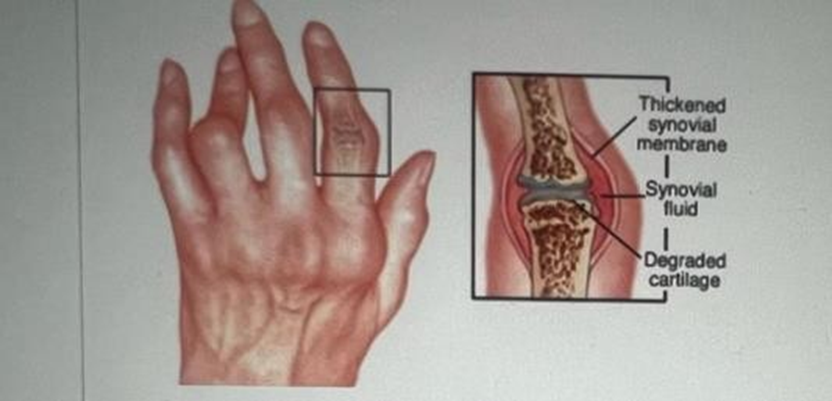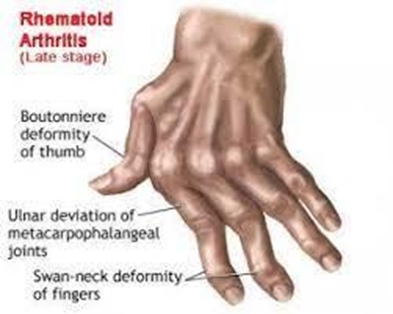The nurse is assessing the hands of a client and notes bony enlargements of the client's joints, as pictured here. The joints are hard, painless, and some of the fingers are deviated from the midline. The nurse suspects these findings are a result of which of the following?

Normal joint wear and tear
Osteomyelitis
Uric acid deposits
Rheumatoid Arthritis
The Correct Answer is D
A. Normal joint wear and tear typically do not result in bony enlargements, deviation of fingers, or hard, painless joints.
B. Osteomyelitis is a bone infection and would present with symptoms such as fever, localized pain, swelling, and redness over the affected bone, rather than bony enlargements of the joints.
C. Uric acid deposits are associated with conditions like gout and would typically manifest as acute attacks of severe pain, redness, and swelling in the affected joint, rather than the chronic, painless joint deformities seen in the scenario described.
D. Rheumatoid Arthritis (RA) is a chronic autoimmune disorder characterized by inflammation of the synovium, leading to joint deformities, bony enlargements, and deviation of fingers. Joints affected by RA are typically hard, painless, and may exhibit ulnar deviation.

Nursing Test Bank
Naxlex Comprehensive Predictor Exams
Related Questions
Correct Answer is ["C","D","F","G"]
Explanation
A. The absence of pain does not necessarily indicate the absence of infection.
B. An oral temperature of 98.9 degrees F is within the normal range and does not indicate infection.
C. Decreased level of consciousness can be a sign of systemic infection, especially if accompanied by other symptoms.
D. An elevated white blood cell count (WBC) is indicative of an inflammatory response, which can occur in infection.
E. A scab forming on the incision line is a normal part of wound healing and does not necessarily indicate infection.
F. Crackles in bilateral lung bases may indicate a possible infection.
G. Redness and warmth at the incision site are signs of inflammation and can indicate infection.
Correct Answer is A
Explanation
A. Rheumatoid factor (RF) is often elevated in individuals with rheumatoid arthritis.
B. CA 125 is a tumor marker used primarily for detecting ovarian cancer and is not specific to rheumatoid arthritis.
C. While increased white blood cell count (WBC) may occur in inflammatory conditions like rheumatoid arthritis, it is not specific to the disease.
D. In rheumatoid arthritis, the erythrocyte sedimentation rate (ESR) is typically elevated rather than decreased.
Whether you are a student looking to ace your exams or a practicing nurse seeking to enhance your expertise , our nursing education contents will empower you with the confidence and competence to make a difference in the lives of patients and become a respected leader in the healthcare field.
Visit Naxlex, invest in your future and unlock endless possibilities with our unparalleled nursing education contents today
Report Wrong Answer on the Current Question
Do you disagree with the answer? If yes, what is your expected answer? Explain.
Kindly be descriptive with the issue you are facing.
